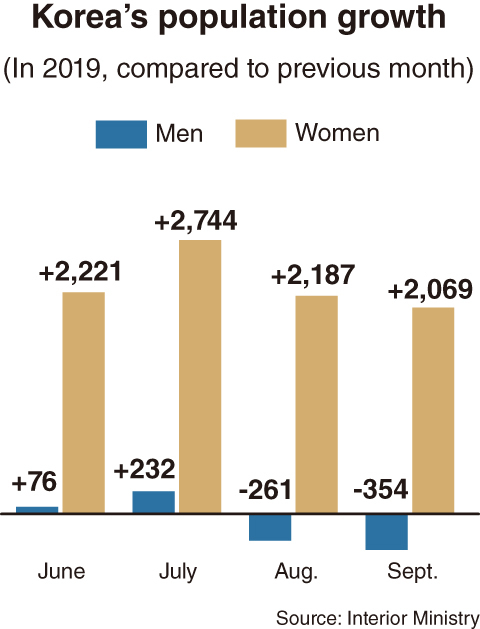[News Focus] Korea faces symptoms of drop in men’s population
By Kim Yon-sePublished : Oct. 22, 2019 - 16:21
SEJONG -- Statistics Korea forecasts that the nation’s population will start declining in 2029 after peaking at 51.94 million in 2028.
By sex, the timing of drop in men will likely come first, beginning from 2026 after reaching an all-time high of 25.97 million in 2025, while the number of women is projected to fall starting from 2031.
But the symptom of an earlier-than-expected drop mode in the men’s population has already surfaced, according to monthly demographic figures held by the Ministry of Interior and Safety.
The number of men across the country dropped by 397 in March 2017 from a month earlier, which marked the first time in Korea’s recorded history, though the male population increased again between April and December 2017 each month.
In 2018, the male population fell three times -- in January by 308, in February by 98 and in December by 242, while it rose during the other nine months of the year.
By sex, the timing of drop in men will likely come first, beginning from 2026 after reaching an all-time high of 25.97 million in 2025, while the number of women is projected to fall starting from 2031.
But the symptom of an earlier-than-expected drop mode in the men’s population has already surfaced, according to monthly demographic figures held by the Ministry of Interior and Safety.
The number of men across the country dropped by 397 in March 2017 from a month earlier, which marked the first time in Korea’s recorded history, though the male population increased again between April and December 2017 each month.
In 2018, the male population fell three times -- in January by 308, in February by 98 and in December by 242, while it rose during the other nine months of the year.

In 2019, the figure for men rose six consecutive months from February to July after falling by 611 in January. But it fell again in August by 261 and September by 354.
That contrasts against the population of women, which increased by 2,187 in August and 2,069 in September this year.
Among the eight major cities and nine provinces, 13 regions reported a drop in the number of male residents, and only four -- Sejong City, Incheon City, Gyeonggi Province and Jeju Province -- posted increases.
Seoul has led the nationwide drop as its number of male residents fell by 3,302 in September, compared to the previous month, to 4.75 million, followed by Busan with minus 1,121 to 1.68 million.
Daegu ranked third with minus 912, trailed by South Gyeongsang Province with minus 582, North Jeolla Province with minus 558, Daejeon with 485, South Jeolla Province with 401, North Gyeongsang Province with 326 and Ulsan with 270.
Data showed that men’s population increases -- of 6,822 in Gyeonggi Province, where many new residential towns have been built, and 808 in Sejong, the fastest-growing city in the nation -- have somewhat offset the declines in the 13 regions.

“The disparity between men and women is attributed to longer lifespan of Korean females, alongside the waning custom of traditional preference for sons,” said a demography researcher in Sejong.
According to the Interior Ministry, the number of men aged 70 or over stood at 2.2 million, compared to 3.22 million among women for the same age groups.
By generation, the populations of men and women in their 70s were 1.59 million vs. 1.98 million, those in their 80s were 552,000 vs. 1.05 million, those in their 90s were 51,000 vs. 175,000 and centenarians were 4,763 vs. 15,113.
The situation is a contrast to numbers of younger generations, in which the number of men currently exceeds women in age groups in their 50s, 40s, 30s, 20s, 10-19 and under 10. Women’s population outstrips men’s from those in their 60s.
In total, the men and women’s populations reached 25.86 million and 25.98 million, respectively, as of last month.
The national average ages for men and women were 41.7 and 43.4, respectively. as of September.
While the sex ratio (the number of men per 100 women) remains at 99.5, Statistics Korea expects the figure will fall to 98.9 in 2040 and further drop to 97.9 in 2054.
Concerning the monthly slide (for three out of the nine months in 2019) in the male population, a government official said a yearly based decrease will likely be feasible in about two years.
He added that the more significant issue is the growing percentage of the senior population, aged 65 or over for both men and women, citing record-low birthrates and falling marriage numbers.
In just 17 years in 2036, the proportion of people aged 65 or over is projected to surpass 30 percent, according to Statistics Korea data. The figure currently stands at 15 percent.
By Kim Yon-se (kys@heraldcorp.com)









![[Hello India] Hyundai Motor vows to boost 'clean mobility' in India](http://res.heraldm.com/phpwas/restmb_idxmake.php?idx=644&simg=/content/image/2024/04/25/20240425050672_0.jpg&u=)








